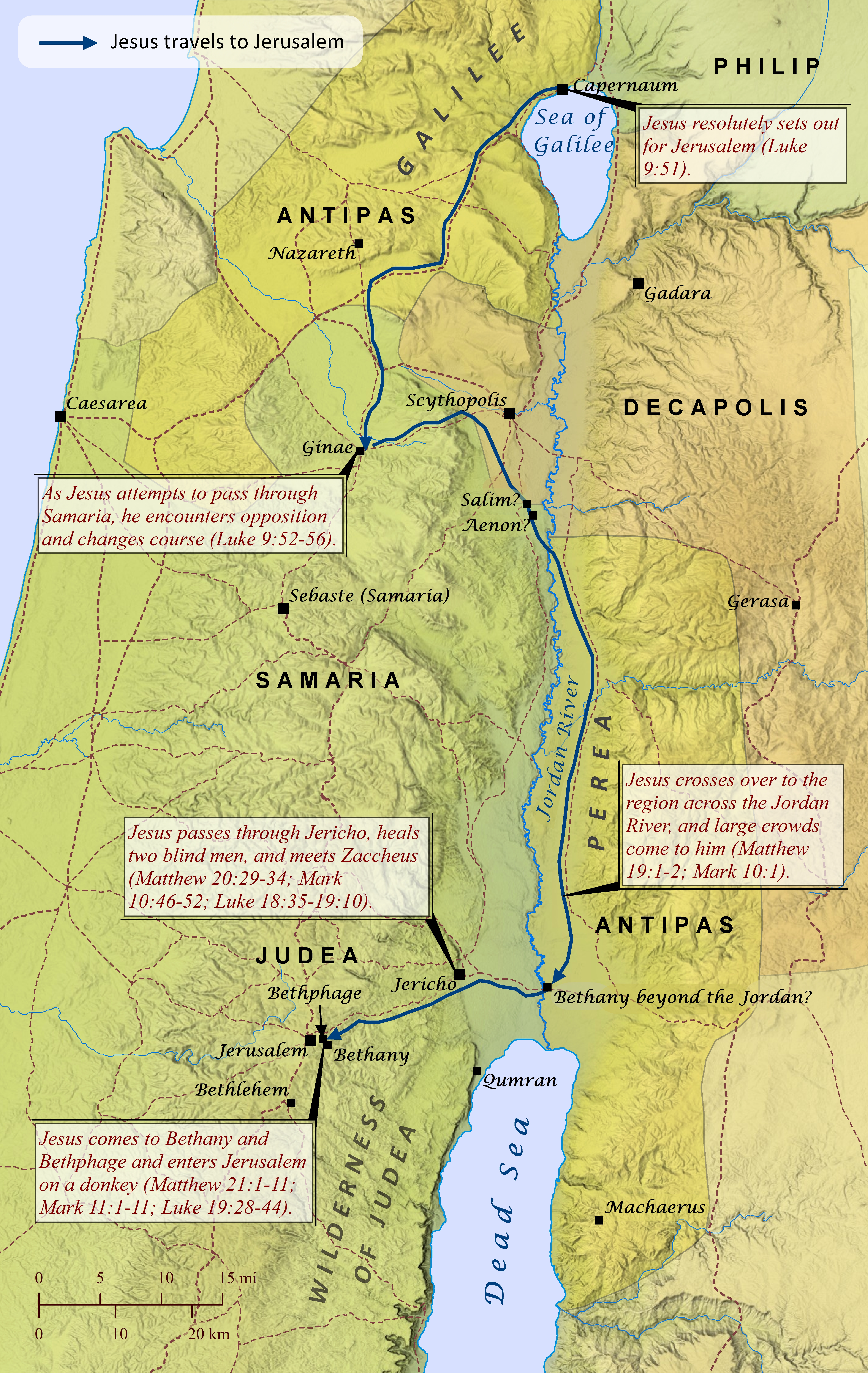Note: This view shows ‘verses’ which are not natural language units and hence sometimes only part of a sentence will be visible—click on any Bible version abbreviation down the left-hand side to see the verse in more of its context. Normally the OET discourages the reading of individual ‘verses’, but this view is only designed as a tool for doing comparisons of different translations—the older translations are further down the page (so you can read up from the bottom to trace the English translation history). The OET segments on this page are still very early looks into the unfinished texts of the Open English Translation of the Bible—please double-check these texts in advance before using in public.
AICNT Jesus stopped and ordered the man to be brought [to him].[fn] When he came near, Jesus asked him,
OEB Then Jesus stopped and ordered the man to be brought to him. And, when he had come close up to him, Jesus asked him,
WEBBE Standing still, Jesus commanded him to be brought to him. When he had come near, he asked him,
WMBB Standing still, Yeshua commanded him to be brought to him. When he had come near, he asked him,
NET So Jesus stopped and ordered the beggar to be brought to him. When the man came near, Jesus asked him,
LSV And Jesus having stood, commanded him to be brought to Him, and he having come near, He questioned him,
FBV Jesus stopped and told them to bring the blind man to him. As he came over, Jesus asked him,
TCNT So Jesus stopped and ordered the man to be brought to him. When the man drew near, Jesus asked him,
T4T Jesus stopped and told people to bring the man to him. When the blind man came near, Jesus asked him,
LEB So Jesus stopped and[fn] ordered him to be brought to him. And when[fn] he approached, he asked him,
BBE And Jesus, stopping, gave orders that he was to come to him, and when he came near, he said to him,
Moff So Jesus stopped and ordered them to bring him, and asked him when he approached,
Wymth At length Jesus stopped and desired them to bring the man to Him; and when he had come close to Him He asked him,
ASV And Jesus stood, and commanded him to be brought unto him: and when he was come near, he asked him,
DRA And Jesus standing, commanded him to be brought unto him. And when he was come near, he asked him,
YLT And Jesus having stood, commanded him to be brought unto him, and he having come nigh, he questioned him,
Drby And Jesus stood still, and commanded him to be led to him. And when he drew nigh he asked him [saying],
RV And Jesus stood, and commanded him to be brought unto him: and when he was come near, he asked him,
SLT And Jesus having stood, commanded him to be brought to him: and he having drawn near, he asked him,
Wbstr And Jesus stood and commanded him to be brought to him: and when he had come near, he asked him,
KJB-1769 And Jesus stood, and commanded him to be brought unto him: and when he was come near, he asked him,
KJB-1611 And Iesus stood and commanded him to be brought vnto him: and when he was come neere, he asked him,
(Modernised spelling is same as from KJB-1769 above, apart from punctuation)
Bshps And Iesus stoode styll, & commaunded hym to be brought vnto hym. And whe he was come neare, he asked him,
(And Yesus/Yeshua stood still, and commanded him to be brought unto him. And when he was come near, he asked him,)
Gnva And Iesus stoode stil, and commanded him to be brought vnto him. And when he was come neere, he asked him,
(And Yesus/Yeshua stood still, and commanded him to be brought unto him. And when he was come near, he asked him, )
Cvdl Iesus stode styl, & comaunded hi to be brought vnto hi. And whan he was come neare, he axed him
(Yesus/Yeshua stood styl, and commanded hi to be brought unto hi. And when he was come near, he asked him)
TNT And Iesus stode styll and commaunded him to be brought vnto him. And when he was come neare he axed him
(And Yesus/Yeshua stood still and commanded him to be brought unto him. And when he was come near he asked him )
Wycl And Jhesus stood, and comaundide hym to be brouyt forth to hym. And whanne he cam nyy, he axide hym,
(And Yhesus stood, and commanded him to be brought forth to him. And when he came nigh/near, he asked him,)
Luth JEsus aber stund stille und hieß ihn zu sich führen. Da sie ihn aber nahe zu ihm brachten, fragte er ihn
(Yesus but stood still(v) and was_called him/it to/for itself/yourself/themselves lead. So they/she/them him/it but near to/for him brought, asked he him/it)
ClVg Stans autem Jesus jussit illum adduci ad se. Et cum appropinquasset, interrogavit illum,[fn]
(Stans however Yesus ordered him adduci to himself. And when/with appropinquasset, asked him, )
UGNT σταθεὶς δὲ, ὁ Ἰησοῦς ἐκέλευσεν αὐτὸν ἀχθῆναι πρὸς αὐτόν. ἐγγίσαντος δὲ αὐτοῦ, ἐπηρώτησεν αὐτόν,
(statheis de, ho Yaʸsous ekeleusen auton aⱪthaʸnai pros auton. engisantos de autou, epaʸrōtaʸsen auton,)
SBL-GNT σταθεὶς δὲ ⸀ὁ Ἰησοῦς ἐκέλευσεν αὐτὸν ἀχθῆναι πρὸς αὐτόν. ἐγγίσαντος δὲ αὐτοῦ ἐπηρώτησεν αὐτόν·
(statheis de ⸀ho Yaʸsous ekeleusen auton aⱪthaʸnai pros auton. engisantos de autou epaʸrōtaʸsen auton;)
RP-GNT Σταθεὶς δὲ ὁ Ἰησοῦς ἐκέλευσεν αὐτὸν ἀχθῆναι πρὸς αὐτόν· ἐγγίσαντος δὲ αὐτοῦ ἐπηρώτησεν αὐτόν,
(Statheis de ho Yaʸsous ekeleusen auton aⱪthaʸnai pros auton; engisantos de autou epaʸrōtaʸsen auton,)
TC-GNT Σταθεὶς δὲ [fn]ὁ Ἰησοῦς ἐκέλευσεν αὐτὸν ἀχθῆναι πρὸς αὐτόν· ἐγγίσαντος δὲ αὐτοῦ ἐπηρώτησεν αὐτόν,
(Statheis de ho Yaʸsous ekeleusen auton aⱪthaʸnai pros auton; engisantos de autou epaʸrōtaʸsen auton, )
Key for above GNTs: red:words differ (from our SR-GNT base).
